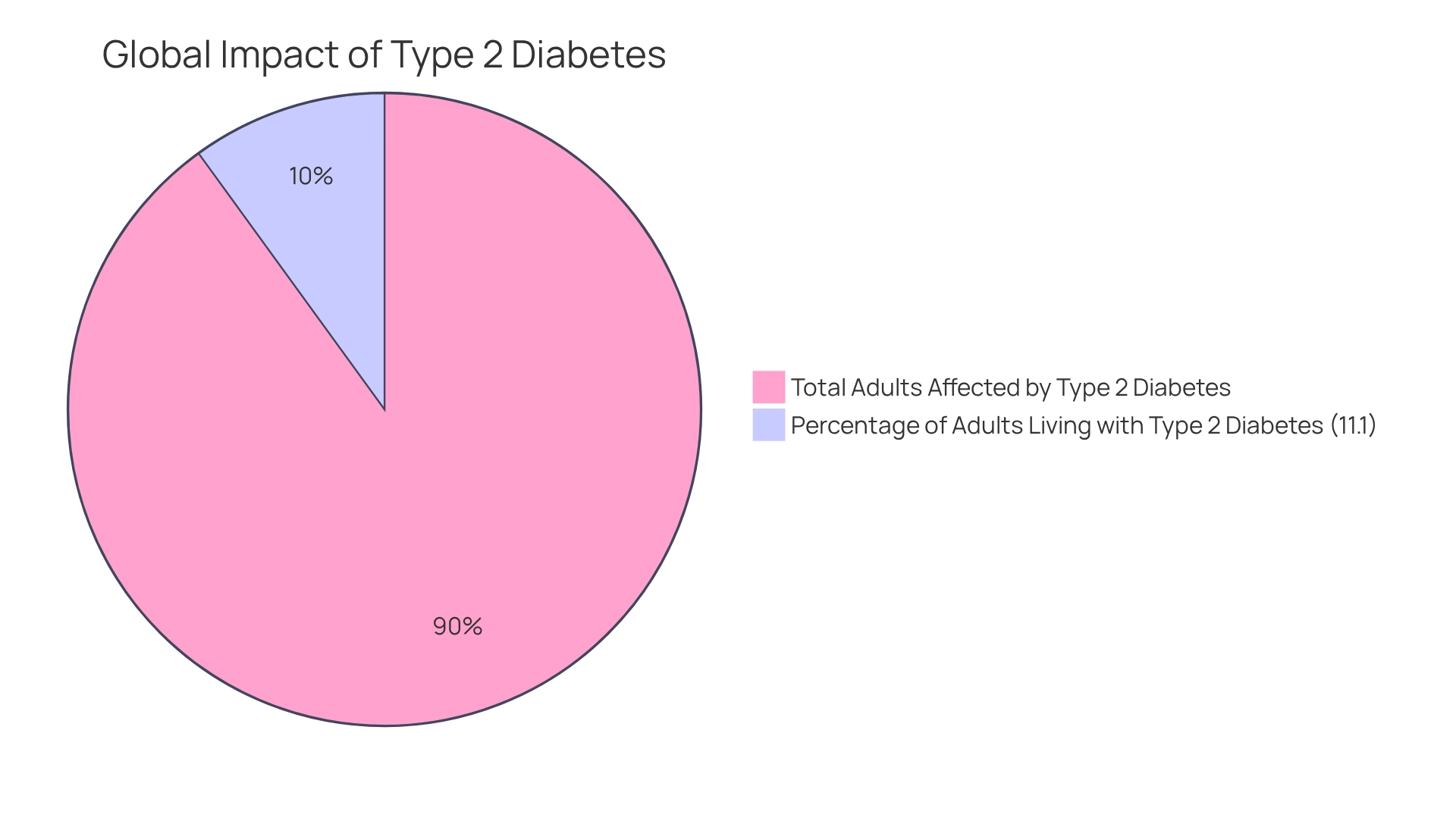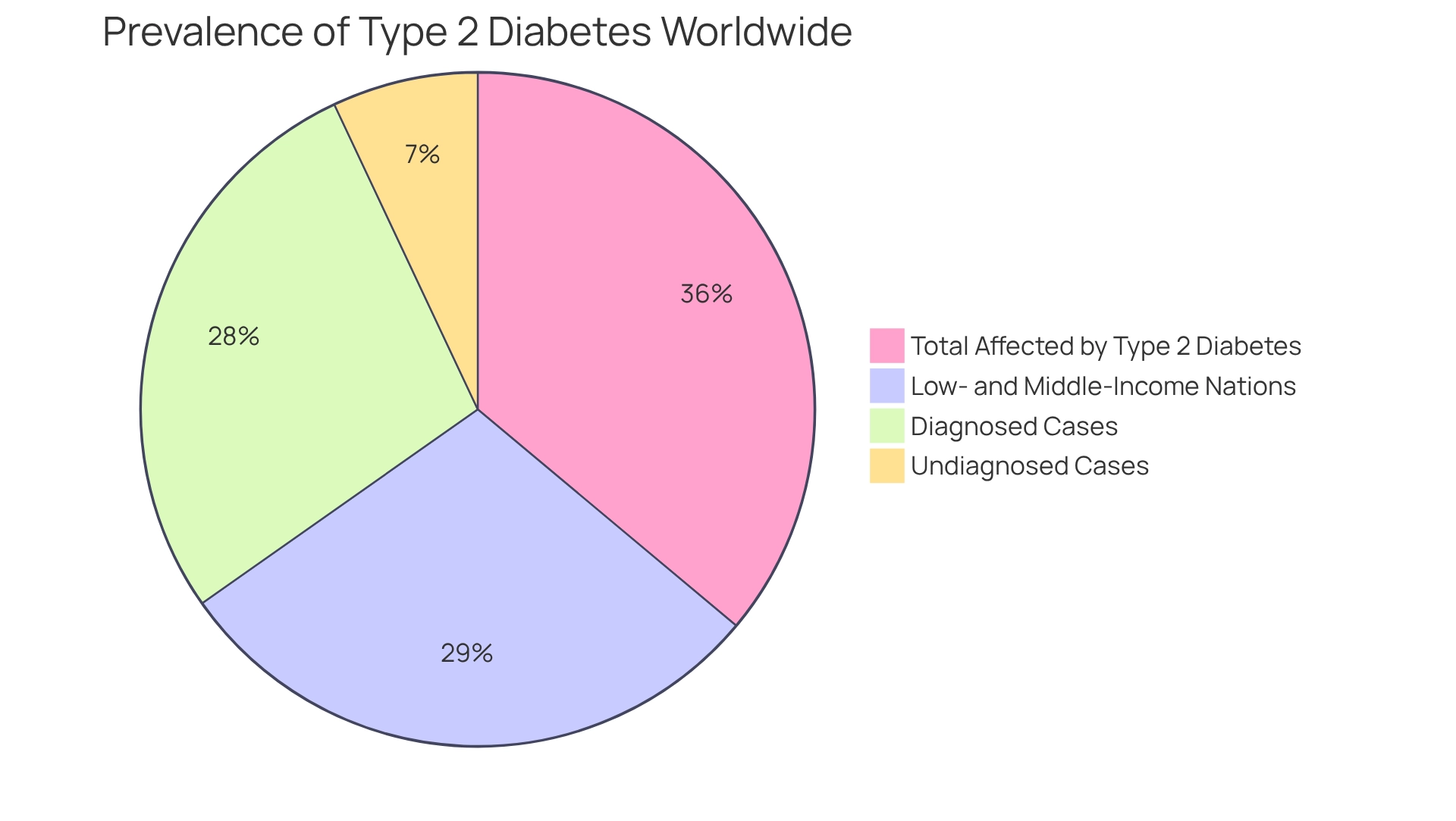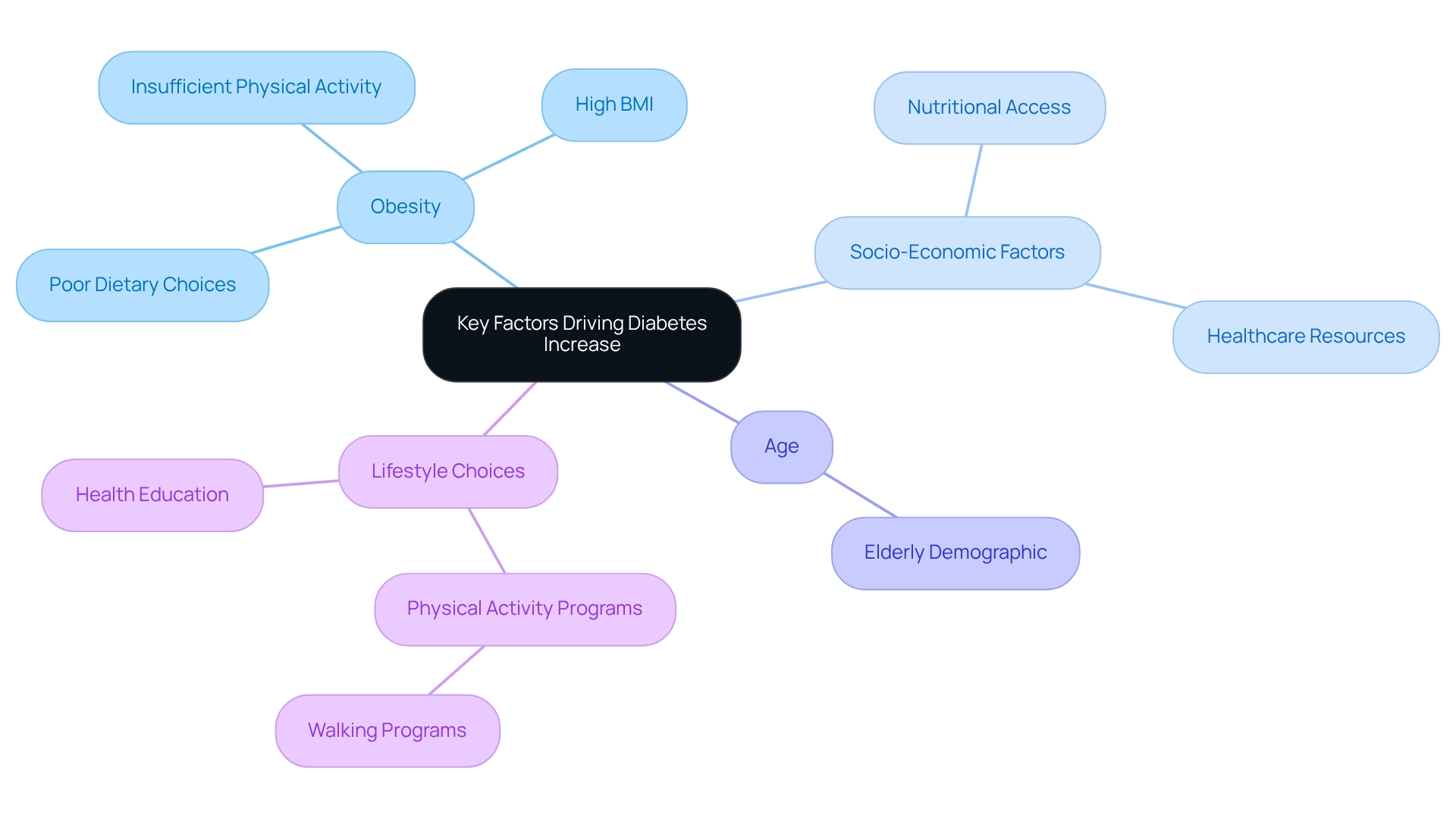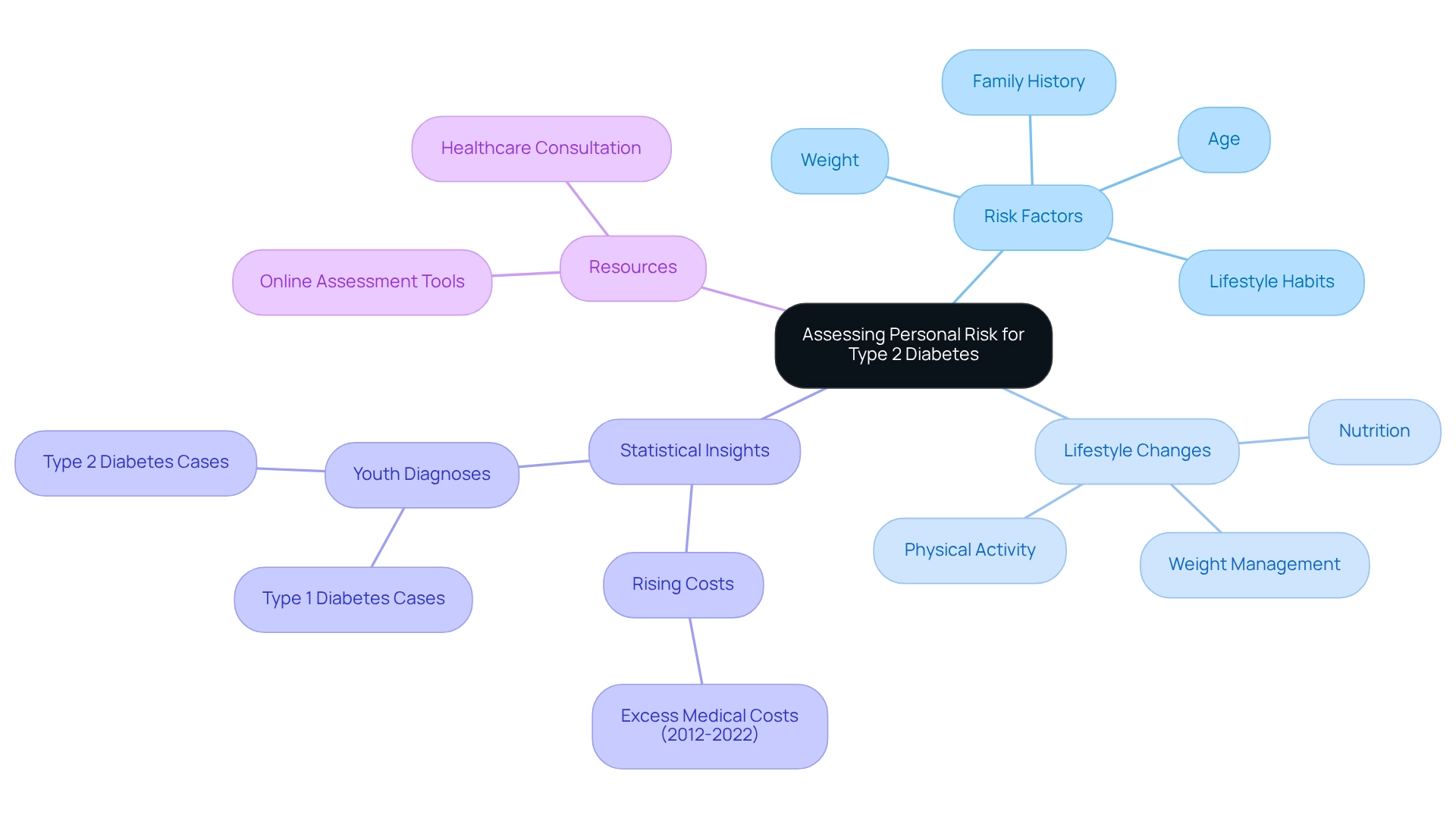Overview
It’s important to recognize that type 2 diabetes is a growing concern, affecting over 800 million adults worldwide. This number is projected to rise to more than 1.3 billion by 2050, largely due to obesity and sedentary lifestyles. Many patients find this alarming, and it’s crucial to address these concerns with compassion and understanding.
The article highlights the urgent need for increased awareness and healthcare access, especially in low- and middle-income countries. By focusing on targeted prevention strategies, we can work together to combat this escalating public health crisis. Remember, you are not alone in this journey, and there are resources available to support you.
As we move forward, let’s embrace the idea of healthier living. Together, we can make a difference, not just for ourselves but for our communities as well. Your health matters, and taking action now can lead to a brighter, healthier future.
Introduction
The global landscape of type 2 diabetes is changing rapidly, and it’s concerning to think that projections indicate over 800 million adults will be affected by 2025. This alarming surge marks a fourfold increase since 1990, highlighting a public health crisis that truly needs our immediate attention. It’s important to recognize that the majority of those impacted live in low- and middle-income countries, where many cases remain undiagnosed.
Many patients find that the complex interplay of obesity, sedentary lifestyles, and socio-economic barriers makes their struggles even more challenging. This reality underscores the need for targeted strategies for prevention and management. With the financial burden of diabetes care expected to exceed $1 trillion by 2045, understanding the factors driving this epidemic is vital.
In this article, we will delve into current statistics, identify key risk factors, and explore actionable steps you can take to assess and mitigate your risk of developing type 2 diabetes. Through a lens of education and personalized care, we can find hope in innovative approaches that may help reverse this growing health crisis. Together, let’s navigate this journey toward healthier living.
Explore Global Prevalence of Type 2 Diabetes
As we look toward 2025, it’s important to recognize how many people in the world have type 2 diabetes, as this form 2 blood sugar disorder has reached a critical worldwide prevalence, affecting over 800 million adults. This staggering number has more than quadrupled since 1990, highlighting a significant public health crisis that many are facing. The International Diabetes Federation (IDF) reports that approximately 11.1% of adults aged 20-79 are living with this condition, which raises the question of how many people in the world have type 2 diabetes, as it constitutes the majority of these instances. Many patients find that the World Health Organization (WHO) emphasizes the urgent need for action, particularly in low- and middle-income countries (LMICs), where nearly 80% of undiagnosed cases are found.
In partnership with WHO, governments of LMICs should focus on improving the accessibility of healthcare programs. This includes more regular screenings for individuals aged 45 years and older, as well as for younger individuals who may be more susceptible. This demographic is particularly vulnerable, making it essential to implement targeted early screening based on family history and risk factors. Additionally, community awareness initiatives are necessary to foster a deeper understanding of this condition and its management.
The financial consequences of this disorder are significant, with worldwide healthcare spending on management expected to exceed $1,054 billion by 2045. These statistics underscore the essential need for effective management and prevention strategies, along with the importance of education and awareness in addressing this escalating medical crisis.
At Integrative Wellness Center, we believe in transforming health management by empowering patients through education and tailored, holistic solutions that address the underlying causes of second-degree conditions. Our services include comprehensive testing, personalized plans, and ongoing support to help you manage and potentially reverse your condition. Contact us today to learn more about how we can assist you on your journey to better health.
Analyze Current Statistics and Trends
Recent studies predict a staggering 59.7% rise in type 2 metabolic disorder occurrence from 2021 to 2025, prompting questions about how many people in the world have type 2 diabetes, potentially affecting over 1.3 billion people by 2050. This alarming rise is closely linked to escalating obesity rates, sedentary lifestyles, and poor dietary choices.
It’s important to recognize that the World Health Organization (WHO) has recorded a notable rise in how many people in the world have type 2 diabetes, as the global prevalence of blood sugar disorders among adults jumped from 7% in 1990 to 14% in 2022. Significantly, 252 million individuals are living with undiagnosed blood sugar issues, which raises the question of how many people in the world have type 2 diabetes, emphasizing the essential need for heightened awareness and screening.
Moreover, over 81% of adults with the condition, which contributes to understanding how many people in the world have type 2 diabetes, reside in low- and middle-income nations, suggesting that specific groups are disproportionately impacted. This requires the formulation of focused strategies to tackle these disparities and enhance wellness outcomes for those at risk.
The International Diabetes Federation (IDF) Diabetes Atlas uncovers significant regional differences in the prevalence of type 2 diabetes, illustrating how many people in the world have type 2 diabetes and emphasizing the urgency of public health initiatives aimed at encouraging healthier lifestyles and improving access to care.
Many patients find that the experiences of those who have participated in Dr. Jason Shumard’s 30-Day Diabetes Reset program are particularly illuminating. Many have reported transformative results, such as significant weight loss, improved blood sugar levels, and a reduction in medication reliance. For example, one patient shared that after beginning the program, their A1C levels decreased from 9.1 to 5.7, and they shed 55 pounds. This highlights the potential for holistic methods to reverse type 2 diabetes.
These personal narratives emphasize the risks of traditional treatments for blood sugar management, which frequently result in elevated insulin levels and dependence on various medications. Instead, Dr. Shumard’s program emphasizes a functional medicine approach, focusing on tailored nutrition, exercise, and community support, which are essential for effective management of blood sugar. Ultimately, addressing these challenges through personalized care and lifestyle changes can lead to improved quality of life and reduced reliance on conventional medical interventions.
Identify Key Factors Driving Diabetes Increase
The increasing occurrence of type 2 conditions worldwide raises concerns about how many people in the world have type 2 diabetes, which can be linked to several key factors, with obesity being the most important, accounting for nearly 60% of cases. It’s important to recognize that high body mass index (BMI) is a major risk factor, often exacerbated by poor dietary choices and insufficient physical activity. Moreover, socio-economic factors greatly impact health issues related to diabetes; individuals in low-income regions often encounter obstacles to obtaining nutritious foods and sufficient healthcare resources. The elderly demographic also plays an essential role, as the probability of developing the second form of sugar disease rises with age.
Many patients find that understanding these interconnected factors is essential for both individuals and healthcare providers to develop and implement effective prevention strategies. Recent findings emphasize that the type 2 condition is largely preventable and potentially reversible if managed early, yet its prevalence raises concerns about how many people in the world have type 2 diabetes, underscoring the need for a deeper understanding of risk factors and disparities across different populations. For example, Tunisia reported 152 Disability-Adjusted Life Years (DALYs) related to this illness in 2021, illustrating the global impact of this condition.
Furthermore, the link between obesity and the occurrence of diabetes-related conditions is pronounced; as obesity levels rise, so do cases of these conditions, highlighting the pressing necessity for focused interventions. Dr. Jason Shumard emphasizes the importance of lifestyle modifications, stating, ‘By providing patients with actionable insights and practical tools, the center fosters an environment where individuals can reclaim their health and well-being.’
To effectively start a walking program, individuals should evaluate their current fitness levels and set realistic goals, such as committing to a daily walk of 10-15 minutes. Including consistent physical activity, like walking programs, can greatly improve wellness and vitality for individuals handling blood sugar management.
Furthermore, complications associated with this condition, such as foot issues resulting in ulcers and possible amputations, emphasize the serious consequences of unmanaged blood sugar levels. By comprehending these elements and establishing organized walking routines, individuals with the second form of the condition can take proactive measures in managing their health while monitoring their progress to remain motivated.
Assess Your Personal Risk for Type 2 Diabetes
Are you concerned about your risk for type 2 diabetes? It’s important to recognize that assessing your personal likelihood can be a crucial step toward better health. Consider using a diabetes assessment that examines key factors such as age, weight, family history, and lifestyle habits. The American Diabetes Association offers a user-friendly online assessment tool to help you effectively identify your likelihood level.
Many patients find that participating in a healthy lifestyle—marked by consistent physical activity, balanced nutrition, and effective weight management—can significantly reduce their chances. If your evaluation suggests a high level of concern, it’s advisable to consult with a healthcare professional for tailored guidance and potential screening options. Remember, timely identification and preventative measures are essential in managing and possibly reversing the development of this chronic condition.
With the increasing occurrence of type 2 diabetes, it is more crucial than ever to understand how many people in the world have type 2 diabetes and address your risk. Did you know that excess medical expenses per individual have risen from $10,179 to $12,022 between 2012 and 2022? Moreover, the concerning trend of rising diagnoses among young individuals, with 5,293 cases reported in children and adolescents during 2017-2018, emphasizes the urgency for preventive actions and wellness education aimed at younger groups.
As Peter M. House aptly stated, “Diabetes is not a burden, but a lesson in perseverance and self-care.” This highlights the importance of resilience in managing this condition. Furthermore, the notable rise in how many people in the world have type 2 diabetes among all racial and ethnic groups from 2002 to 2018 emphasizes the necessity for awareness and proactive wellness measures.
To support your journey toward improved well-being, consider starting a walking program. This structured approach not only enhances your physical activity but also empowers you to take control of your health. By gradually increasing your walking duration and frequency, you can significantly improve your overall wellness and vitality. Remember, at Integrative Wellness Center, we are dedicated to transforming healthcare through personalized, patient-centered care. Contact us today to learn more about how we can assist you in managing and potentially reversing the condition that affects how many people in the world have type 2 diabetes.
Conclusion
The escalating prevalence of type 2 diabetes presents a formidable public health challenge that cannot be ignored. With projections indicating that over 800 million adults will be affected by 2025, it’s important to recognize the urgency for effective prevention and management strategies. The interplay of obesity, sedentary lifestyles, and socio-economic factors has exacerbated this crisis, particularly in low- and middle-income countries where many cases remain undiagnosed.
Addressing these challenges requires a multifaceted approach that includes increased awareness, education, and personalized care. Many patients find that initiatives such as early screening and community sensitization can significantly impact health outcomes, especially for vulnerable populations. The evidence underscores that type 2 diabetes is largely preventable and, in some cases, reversible through lifestyle modifications and targeted interventions. Programs that emphasize holistic approaches, like Dr. Jason Shumard’s 30-Day Diabetes Reset, demonstrate the potential for transforming lives through effective management.
Individuals are encouraged to assess their personal risk and take proactive steps towards healthier living. Utilizing tools such as diabetes risk assessments and engaging in regular physical activity can empower individuals to mitigate their risk and improve their overall health. As this health crisis continues to unfold, the collective responsibility to foster healthier environments, promote education, and enhance access to care will be crucial in curbing the tide of type 2 diabetes. The journey towards better health begins with awareness and action, paving the way for a brighter, healthier future for all.
Frequently Asked Questions
How many adults worldwide are affected by type 2 diabetes?
Over 800 million adults are affected by type 2 diabetes, which constitutes approximately 11.1% of adults aged 20-79.
How has the prevalence of type 2 diabetes changed since 1990?
The prevalence of type 2 diabetes has more than quadrupled since 1990, highlighting a significant public health crisis.
What percentage of undiagnosed type 2 diabetes cases are found in low- and middle-income countries (LMICs)?
Nearly 80% of undiagnosed cases of type 2 diabetes are found in low- and middle-income countries (LMICs).
What actions should governments in LMICs take to address type 2 diabetes?
Governments in LMICs should focus on improving healthcare accessibility, including regular screenings for individuals aged 45 and older, as well as younger individuals at higher risk.
Why is community awareness important in managing type 2 diabetes?
Community awareness initiatives are necessary to foster a deeper understanding of type 2 diabetes and its management, which is crucial for effective prevention and care.
What are the expected financial implications of managing type 2 diabetes by 2045?
Worldwide healthcare spending on management of type 2 diabetes is expected to exceed $1,054 billion by 2045.
What approach does Integrative Wellness Center take towards managing type 2 diabetes?
Integrative Wellness Center focuses on empowering patients through education and tailored, holistic solutions that address the underlying causes of the condition, offering comprehensive testing, personalized plans, and ongoing support.



